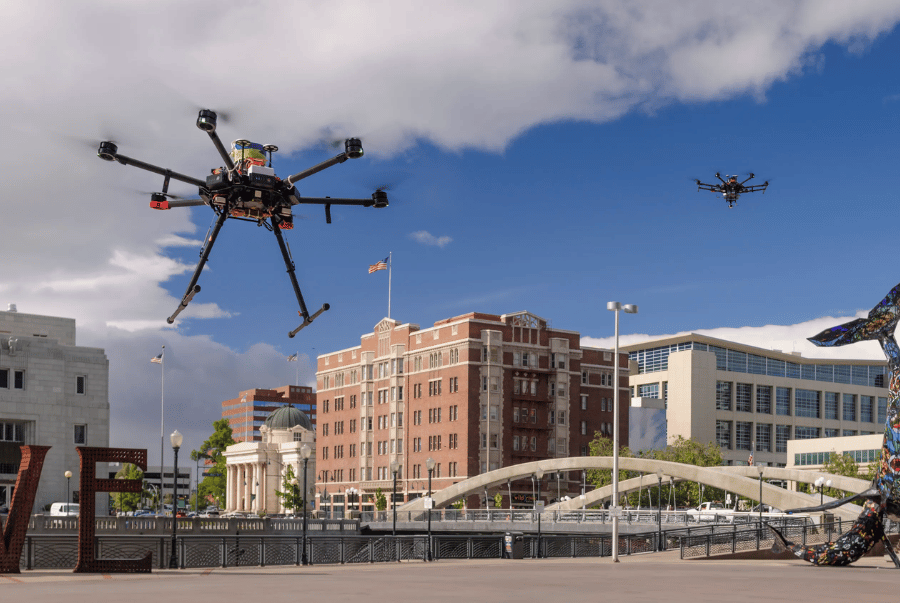Unmanned Traffic Management (UTM) and XBStation’s vision for the future
As drones are increasingly adopted across multiple sectors, UTM (Unmanned Traffic Management) has emerged as a critical platform to monitor, coordinate, and integrate low-altitude flight operations into national airspace. XBStation is one of the pioneers in building the digital infrastructure for the sky. This is an essential step toward enabling a multi-billion-dollar low-altitude economy.
1. What is UTM and what are the objectives of UTM?
According to the Federal Aviation Administration (FAA), UTM (Unmanned Traffic Management) is a traffic management system designed for unmanned aircraft operating in low-altitude airspace (below 1,000 meters). It is considered a foundational framework to safely and efficiently integrate drones into the modern aviation ecosystem.
The UTM system is established to achieve four core objectives:
Safe integration: UTM enables drones to operate within the same airspace as manned aircraft without conflicts or disruptions.
Operational transparency: It provides real-time flight data, ensuring authorities and the public can easily track drone operations.
Security and collision avoidance: UTM supports monitoring and deconfliction to prevent mid-air collisions between unmanned and manned aircraft.
BVLOS enablement: By enabling Beyond Visual Line of Sight operations, UTM unlocks advanced use cases such as agricultural surveillance and urban logistics, boosting productivity by up to 30%.

At present, UTM relies on three main technology pillars:
Artificial Intelligence (AI) & Machine Learning: These technologies predict flight trajectories, optimize routing, and detect operational risks. For instance, the UTM platform from Esri China applies AI for real-time monitoring and conflict management among UAVs.
5G and Internet of Things (IoT): They ensure low-latency, high-reliability data transmission between drones and control systems, enabling scalable fleet management. Ericsson noted that 5G can accelerate data processing for the low-altitude economy by up to 10× compared to 4G.
UTM Framework: According to ICAO, UTM capability ranges across four maturity levels: from Level 1 (basic operations) to Level 4 (full integration with conventional air traffic control). FAA’s 2025 roadmap predicts BVLOS regulatory standardization by 2026, with UTM serving as the backbone.
UTM is the only way to unlock the full potential of the Low-Altitude Economy (LAE). Without UTM, large-scale and autonomous drone operations would not be safe, compliant, or economically viable. In other words, not UTM, not LAE.
2. The current status of UTM in Vietnam and its future directions
Currently in Vietnam, regulatory bodies, research institutes, and businesses are gradually building a UTM system to meet the growing demand for UAV applications across multiple sectors:
Technology development: Vietnam is focusing on research to monitor, detect and neutralize unauthorized or hostile UAVs, thereby safeguarding national airspace.
Counter-UAV systems: The country is developing integrated counter-UAV platforms equipped with surveillance, localization, and radio-jamming capabilities to protect strategic zones.
Research and collaboration: Technology firms such as XBStation and Viettel Aerospace, along with technical universities, are engaged in developing UTM models tailored to the Vietnamese environment.
Domestic market: Vietnam is gradually shaping the UTM systems market, with both domestic and international companies investing in R&D and real-world applications in logistics, agriculture, healthcare and smart cities.

With UAVs becoming increasingly ubiquitous, deploying UTM is an inevitable step for Vietnam to:
Ensure UAV operations can safely coexist with traditional manned aviation in the future.
Legalize and safely manage large-scale drone delivery operations.
Keep pace with global trends in unmanned airspace management.
To achieve this, state regulators, logistics enterprises, and defense and technology firms must cooperate to build a unified legal framework, technical standards, and shared data infrastructure for UTM in Vietnam.
3. XBStation’s vision for UTM
XBStation aims to become a company specializing in connectivity solutions and automated navigation for UAVs. Its development strategy is built around two key technology pillars:
Connectivity: Establishing a multi-channel data infrastructure (4G/5G/satellite) that ensures drones maintain stable and secure communication under all conditions.
Cloud Server: Creating a centralized flight management platform that stores and analyzes real-time data, thereby enabling coordination of all low-altitude airspace operations.
XBStation is a Vietnamese technology company developing intelligent connectivity solutions for drones and UAVs. Its standout products include XBLink Plus, XBLink SAT, and more.
With a long-term and distinctive vision, XBStation is helping propel Vietnam into the era of smart aviation through UTM. Every UAV flight opens up unprecedented opportunities for the economy, logistics, and innovation.